Let me introduce you to something I learned in Bob Mayer’s workshop.
It’s called Conflict Lock. What is it? It’s the foundational cornerstone of your story, that’s all!
…and it’s tough to get it right.
It is one of the most important things I took away from the workshop. Conflict Lock and Original Idea.
The Original Idea is simply the thing that initially got you fired up about writing the tome you’re working on now. You know that beast you keep trying to slay, but somehow, some way, you lost it? Yeah, that one.
Finding the Orignal Idea is sometimes like finding one noodle in a bowl of spaghetti, but it’s what your story hangs from. Even better, it’s what drives your story. The Original Idea helps with the conflict lock, and they are loosely tied together. Original Idea is later.
But back to Conflict Lock. What is it? How can it help your story? It’s a great tool. It forces you to look at what your protagonist wants, what your antagonist wants and if what they want is at odds with each other. Your protagonist and your antagonist either have competing goals or similar goals. They either want the very same thing and fight for it, (a macguffin) or they want opposite things and fight to get things their way. Often, however, writers don’t a) truly identify their protagonist and their antagonist b) define the conflict in the story c) have real, tangible goals for each of their main characters.
You must see if the protagonist will defeat the antagonist and achieve his goal. When the reader gets this answer, your story is over.
To simplify, I will do a conflict lock on Artis, a short story I wrote a few years ago. (A 2nd place finisher in the Cross Quarter CrossTIME short story contest…also published in the CrossTIME Science Fiction Anthology, Vol. IV (go get yours on Amazon.com!)
Artis is dystopian tale about a boy growing up in a compound with other children. All of them are locked away until they reach the age of majority.
So, obviously my protagonist is Artis. He is the one the camera follows throughout the tale. Artis wants to go outside the compound. Who’s the antagonist? Good question. (I am literally working through this right now!) So, let me draw up a nifty little Conflict Box.
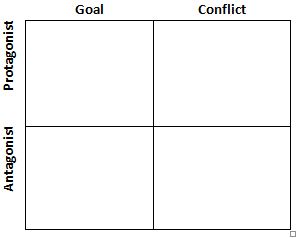
Okay, the Conflict Box helps me better visualize my characters and what they want.
So what’s my protagonist’s goal? Well, Artis wants to get the hell out of the compound and see what all the fuss is about Adulthood. He doesn’t know why children are locked into the compound, but knows once they are grown, they will go outside and be adults. He can’t wait until then.
So his goal is to go outside. Is that a tangible goal? Hard to put that one down, I guess. The goal must be something he can actually touch, (typically!) so I suppose getting out of the compound is a good goal for him. If he succeeds, he’ll be outside. What he does when he gets out there is an entirely different matter. The boy hasn’t thought that far ahead. He’s just a boy, come on!
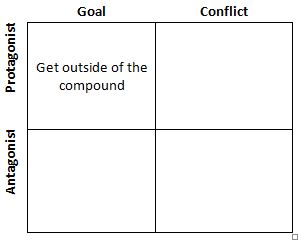
Okay, what’s keeping him from getting outside? Well, probably the armed guards, the 20-foot high walls, the cameras on every wall, and the people who run the compound. All that business. So, in essence, the entire structure adults have put in place to keep him in the compound are what’s keeping him inside. How to word that? The System! Yes, that’s what keeps him inside, he must beat “The System.” As trite and corny as that sounds. That is what is stopping him from achieving his goal.
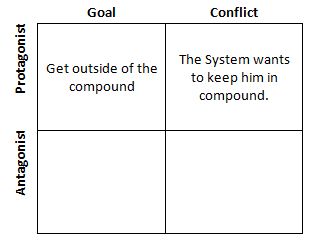
So then who is the antagonist? I can only imagine it’s The System. This is a “man versus environment” take if ever I’ve seen one. Ok. Sweet. That was easier than I thought. Sometimes identifying the antagonist is difficult, because it ain’t always who you think it is. (The same goes for your protagonist.)
So now I have this:
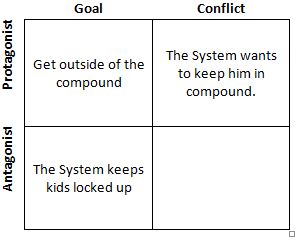
Okay, so far so good. I think I’ve got my protagonist down, and my antagonist down. I hope I do. It seems okay to me. I’ve got three out of the four blocks complete. Anyone see anything wrong? Bob? Wait…he’s probably off penning his next book, not reading my tired ass blog. Okay, so let’s ID the conflict for the antagonist. What would be the conflict for The System? What obstacle would be in place to block them from what they want? Nothing? Hmm… They want to keep Artis (and all the other kids) locked up. Not merely because they want to, but because it is the law. Dang it. I need that final box! You see what I mean.
Now I’m sure Bob (or Jennie Crusie) would tell you that not every story fits into the Conflict Box. But most do, and you should try to get it to work for your story. Why? Because it ensures you don’t have a protagonist and an antagonist battling for completely different reasons for things that don’t really bring them into conflict with each other. If your antagonist wants a bowl of jello, and your protagonist wants a new maserati…there’s not much conflict between the two.
So back to the conflict box. (in real time, about 45 minutes have passed) I think I have it. Well, I have something, so who the hell knows if it’s right or not, but I’m going to put it in.
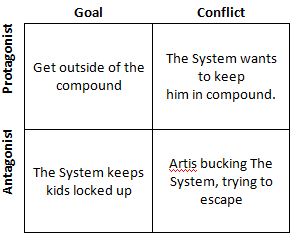
You like that squiggly under his name? Screen prints are awesome. The things I do for you!
Okay, now I’ve got every box filled. Good for me. Is it correct? Only a few people on this earth know, and you’re not talking to one of them. (Err…reading one of them).
So how does one have a true “Conflict Lock”? Simple. You cross diagonally the antagonist and the protagonist’s conflicts…Do they conflict? Let’s see.
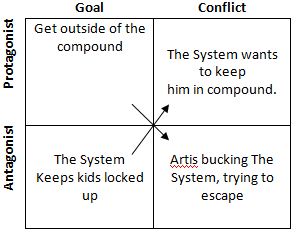
Okay, so to see if your conflict is something that is inescapable, you see if your antagonist’s goal is causing your protagonist’s conflict, and is your protagonist’s goal causing your antagonist’s conflict? That, my friends, is Conflict Lock. The antagonist and protagonist goals are locked since each goal is the other’s conflict.
Now, bear in mind, I may have misappropriated information here and the lock might be as tenuous as my grip on reality, but you get it, right? Does this help? Yeah. Will Bob now sue me for copyright infringement? No. I don’t have enough to make it worthwile…yet.
Now, I am trying to show you something I learned, and hopefully, I learn in the process of showing it to you. If you did get something out of this–sweet! If not, sorry pal. Maybe next time.
You really should give this a try, and see if you can put your story into it. It’s really good to do before you start writing because it allows you to identify the conflict lock, and FINE TUNE it before you start writing. If you want the true nuts and bolts, go see Bob Mayer’s site and take one of his courses. He does this a whole lot better than I have done. So Bob, if you do read this, sorry for butchering your great idea.
Good luck with the Conflict Box. Next time I would like to attempt an explanation of the Original Idea…it’s not just for breakfast any more.
I crack myself up.
Iapetus999
09/08/2009
Very good info. I really want to do this workshop. It’s just a case of $ right now.
I really like the goal-based approach.
Another way to think about this is to consider the antagonist the opposite (Evil Twin) of the protagonist. It’s because they really are the same person. Each would behave the same way if they were in the other’s shoes.
In your case, the Boy wants to be the System, and the System wants to be the Boy. The System refuses to acknowledge the boy in itself. The Boy refuses to acknowledge that the System was made for a reason.
Here’s the thing.
The boy cannot prevail until the System is made to acknowledge its boy side, and the boy cannot realize his dreams until he *is* the System.
Hope that makes sense 🙂
jasonamyers
09/09/2009
Yeah, I am picking up what you’re laying down. Good stuff.
Julee
09/09/2009
Wow. I have a conflict box for my novel I wrote for NaNo last year and didn’t even know it. Great stuff here – thanks! Now if I can just figure out why the antagonist does what he does (so far he doesn’t even know why he does it) and choose the ending I want…
beth
09/12/2009
Oh, I really like this! I’ve never seen this before, but it makes a very clear picture of plot and conflict. Thanks for sharing!
Teresa
09/12/2009
Jason, you really explained that very nicely. If it’s all right with you, I’d like to include this post on my weekly lunch hour links next Wednesday. After I print it out and add to my notes, of course!
Thanks for sharing this with us.
Teresa
jasonamyers
09/12/2009
Sure thing. Add it to whatever you need to. I got the info and am passing it on, so if it keeps getting passed–great!